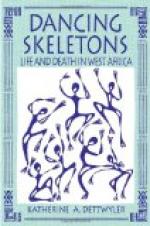|
This section contains 1,015 words (approx. 4 pages at 300 words per page) |

|
Materials. Evidence exists of several materials being used to produce both woven and beaten cloth between 500 and 1590 in West Africa. These include palm-tree bark from the forest region; camel and goat hair; young raffia palm-leaf fibers; bast fibers from stems of various local plants, including the hibiscus plant; cotton; flax for linen; thread produced by the West Africa native Anaphe silkworm; and mineral asbestos for a linen-like fireproof cloth. In addition, West Africans evidently used indigo for dyeing and gum for finishing the surface of cloth. Trade of indigo, gum arabic, cotton, and flax to feed the textile craving was prodigious from the seventh century onward.
Sundiata's Influence. Less known than his military and political innovations is Sundiata's enormous influence on agricultural development. Mari-Jata (the Lion King or Sundiata) at the Gbara (Great Assembly) helped the tribes form a constitution...
|
This section contains 1,015 words (approx. 4 pages at 300 words per page) |

|




